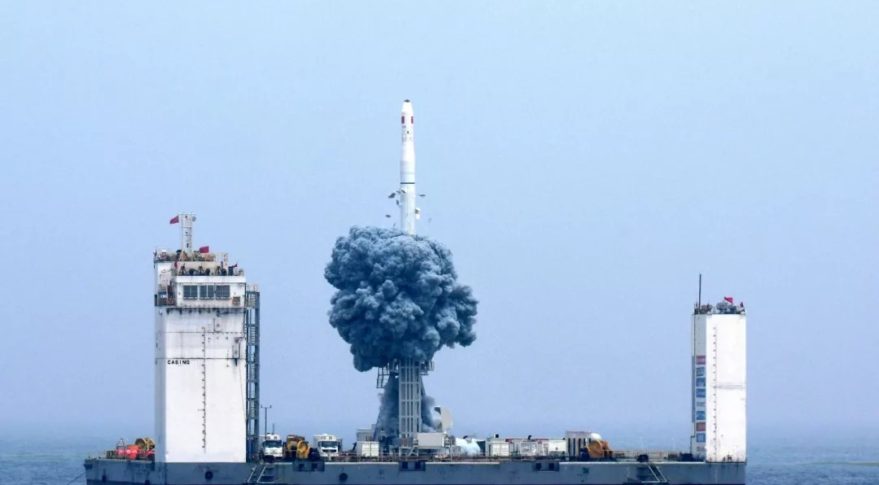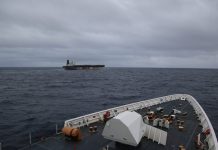Chinese state-owned and private businesses are seeking to develop the ability to launch liquid-fueled rockets from sea platforms to expand the nation’s launch options. EurAsian Times had earlier reported on China’s ambitious plan and decoded its ‘blue book’.
State-owned China Academy of Launch Vehicle Technology (CALT) and private companies like Orienspace are building larger liquid-propellant Gravity series rockets and modifying Long March 8 launchers for sea launches.
Beijing has already shown that it can launch the Long March 11 solid rocket from ocean platforms. The Chinese Space Agency is employing a new spaceport in the eastern coastal province of Shandong, close to Haiyang, to conduct these launches.
Perturbed By China, Another ‘Worried Neighbour’ Joins The Hypersonic Race; Combustion Flight Test Of Scramjet Engine By Month End
The report noted that the Haiyang seaport is alluring a diverse range of space sector firms and nurturing an industry chain. A 162.5-meter-long, 40-meter-wide “new-type rocket launching vessel” is currently under construction and is anticipated to conduct the first launch in 2022 after using repurposed vessels.
Additionally, the area is drawing sizable investments from private businesses. With a planned $119 million investment, the liquid rocket component startup RSpace is currently building a 230-acre manufacturing and testing plant for storage tanks and liquid rocket body structures at Haiyang.

The project is a crucial endeavor for Shandong and has support from the city and province. The development shows a concentrated effort to promote liquid sea launches as well.
Recently, the company tested propellant tanks’ insulation and thermal performance measuring 3.35 meters in diameter.
One potential customer is Orienspace, established in late 2020. In 2022, the company raised $47 million and $59.9 million in pre-A and A-series funding rounds.
Currently, it plans to launch its Gravity-1 solid rocket in the middle of 2023. Following that will be the Gravity-2 kerosene-liquid oxygen launcher.
Galactic Energy, a private launcher service provider, wants to launch its third Ceres-1 solid rocket within the next few months. The vehicle may be tested for a sea launch by the end of the year.
The China Aerospace Science and Technology Corp-owned CALT, one of China’s top state-owned launch vehicle designers and manufacturers, is now considering making the Long March 8 kerosene-liquid oxygen launcher suitable for sea launch.

China’s Growing Sea Launch Capabilities
On April 30, China launched five satellites into orbit on a rocket lifted from a sea platform, setting a new distance record for China’s offshore launches. The launch was China’s farthest offshore liftoff to date.
Also, it was Beijing’s third sea launch since 2020, when it launched Long March 11 boosters from its De Bo 3 platform.
According to translated statements from China Aerospace Science and Technology Corporation officials, the country plans to use the Long March 11 to launch up to three sea-based missions in addition to its conventional land-based missions in 2022.
With the development of sea launch technology, China will be able to launch medium and large satellites and constellations “both on land and sea,” especially into low-inclination low-Earth orbits, maintaining its competitiveness in the quickly developing space industry.
The potential for sea launches of the reusable Long March 8 is examined in a 2021 paper published in the Chinese Journal of Aeronautics. The paper describes the potential launcher as a “low-cost, highly reliable, and easy-to-use vehicle, revised for the commercial market, which is preferable for sea launches.”
The authors note that more research is needed into safety control of the launch site and drop zones for spent rocket stages, but it also points out that there are fewer restrictions for launch and reusable launcher recovery at sea.

In China’s situation, sea launch capabilities might reduce the dangers to the country’s civilian population. Since three of China’s four national launch facilities are deeply inland, rocket stages frequently endanger populated areas when they fall to the ground rather than the ocean. Launch expense increases by evacuating areas within rocket stage drop zones.
Meanwhile, a new launch complex for commercial launches is currently developed at the Wenchang spaceport on the island of Hainan, which may someday host sea launches.
In recent years, China’s launch rate has rapidly increased. In 2015, China conducted 19 launches, all using Long March rockets. In 2021, the nation launched 55 rockets, including private commercial missions.
To help meet the growing demand for launches, China developed Haiyang for sea launches and decided to expand the Jiuquan Satellite Launch Center in the Gobi Desert to facilitate solid and liquid commercial rockets.
Centers for commercial launch are also developed in Wenchang and Ningbo.
- Contact the author at ashishmichel@gmail.com
- Follow EurAsian Times on Google News




